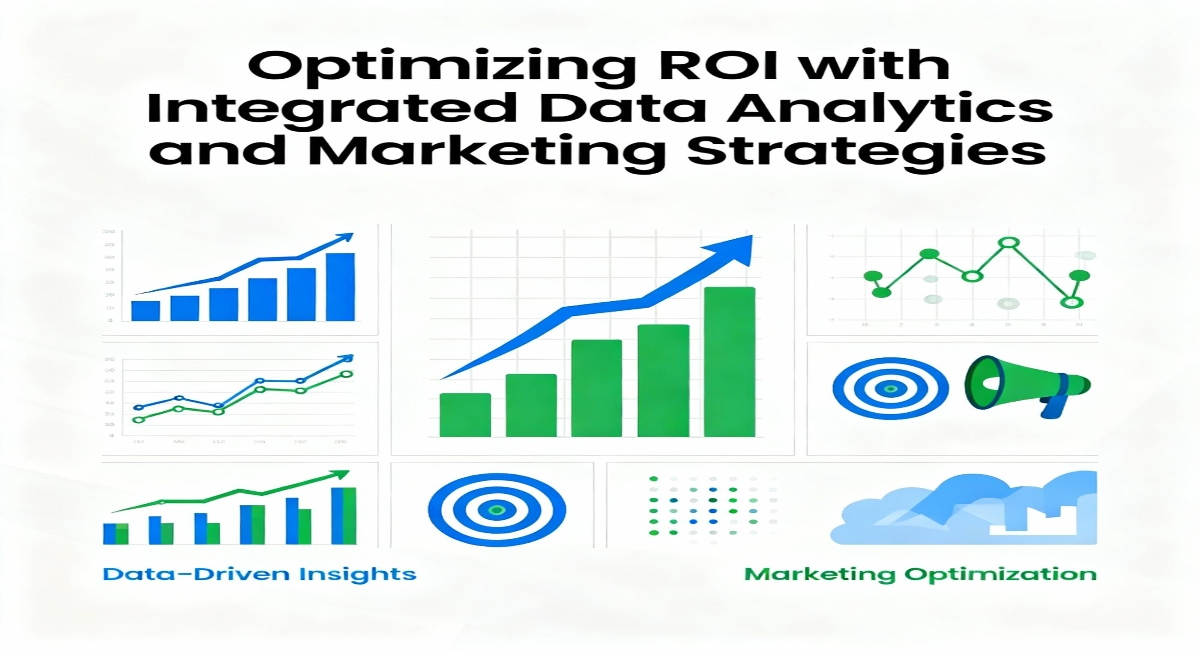
Maximizing ROI with Integrated Data Analytics Strategies
- Technology
- Neha Zubair
- 2025-11-03
- 564786
Introduction: Why ROI Hinges on Data and Strategy
In today’s hyper-competitive marketplace, data is no longer just numbers, it’s the lifeline of decision-making. Yet, many organizations are sitting on a goldmine of unused data. Reports suggest that nearly 73% of enterprise data goes unused for analytics. This inefficiency directly impacts revenue growth and operational ROI. For C-level executives like you, the challenge is not data scarcity but effectively integrating data analytics services with marketing strategies to turn information into actionable insights.
The New Business Reality: Data as a Growth Engine
Every business generates mountains of raw data through customer interactions, supply chains, social media, and sales funnels. Without data analytics solutions, this data remains noise rather than a strategic asset. By embracing analytics, executives can:
- Forecast demand more accurately
- Optimize marketing campaigns in real-time
- Personalize customer experiences for higher retention
Organizations using advanced analytics solutions report up to 45% improved marketing ROI compared to competitors relying solely on traditional methods.
C-Level Decision Making and the Analytics Advantage
As a C-level executive, you need clarity—not more data dumps. Data analytics companies specialize in translating raw information into executive-ready insights. By integrating predictive modeling, behavioral analytics, and performance dashboards, you gain the ability to measure ROI at every stage of your marketing funnel. Imagine reallocating budgets away from underperforming campaigns within days instead of quarters—that’s the power of analytics.
The Role of Integrated Data Analytics Services
When marketing strategies and analytics work in silos, organizations lose efficiency. Integrated data analytics services unify your customer, sales, and operational data into a centralized ecosystem. This creates a 360-degree view of customer behavior. For instance, a retail brand integrating marketing and inventory analytics can ensure high-demand items are in stock before launching promotions, directly maximizing ROI.
Marketing Strategies Powered by Data
Marketing without analytics is like sailing without a compass. With data-driven strategies, you can:
- Identify segments that deliver the highest revenue
- Predict churn and re-engage at-risk customers
- Optimize multichannel campaigns for cost-effectiveness
Recent studies show that companies using analytics-driven marketing strategies see 30-35% higher customer lifetime value than those using traditional approaches.
Why Businesses Turn to Data Analytics Consultants
Hiring data analytics consultants is not just a matter of outsourcing; it’s a smart investment. Consultants provide:
- Expertise in selecting the right tools and technologies
- Custom frameworks aligned to your industry needs
- Roadmaps to ensure your analytics investments yield measurable ROI
Think of them as the translators bridging your business goals with technical execution. The real value lies in their ability to generate insights that are easily consumable by C-suite executives.
Advanced Analytics Solutions: Beyond Conventional Reporting
Standard dashboards show you "what happened," but advanced analytics solutions answer "what’s next." Predictive analytics, machine learning, and prescriptive modeling help organizations anticipate customer behaviors and market shifts before competitors. For example, a financial services firm can proactively identify clients likely to require new investment solutions instead of reacting after opportunities are missed.
The ROI Factor: Calculating the Impact of Analytics
Return on Investment is the core metric for every C-level strategy discussion. Using analytics, you can directly tie marketing spends to revenue outcomes. Research highlights that organizations adopting data analytics solutions achieve up to 25% cost savings in marketing spend due to better targeting and reduced waste.
By measuring ROI through clear KPIs—cost per acquisition, customer lifetime value, and campaign uplift—you shift marketing from a cost center to a profit-driving function.
Overcoming Common Adoption Challenges
While the potential is immense, adoption is often hindered by challenges such as:
- Data silos across business units
- Lack of skilled in-house talent
- Resistance to cultural and process change
That’s where data analytics companies deliver value. They provide scalable solutions that integrate with your existing systems, ensuring minimal disruption and faster implementation timelines. Executives who partner with trusted providers typically see analytics projects paying for themselves in under 12-18 months.
Future Outlook: Data-Driven C-Suites
The future belongs to organizations where the C-suite embraces analytics not as a support function, but as a strategic pillar. In the US alone, the analytics services market is expected to grow at 14% CAGR over the next five years, highlighting the demand for integrated solutions. As business landscapes evolve, executives with strong data analytics strategies will enjoy a competitive edge, higher customer loyalty, and optimized growth trajectories.
Practical Action Steps for Executives
If you are considering investing in analytics, here are steps to ensure success:
- Define clear ROI-centric objectives before investing in tools.
- Start with small pilot projects in marketing to demonstrate quick wins.
- Partner with experienced data analytics consultants for strategy alignment.
Invest in change management to ensure adoption across teams.
By following these steps, organizations not only achieve immediate efficiency but build a sustainable framework for long-term data-driven growth.
Conclusion
At the executive level, decisions must be driven by more than instinct. Integrated data analytics services and marketing strategies empower leaders to transform raw data into smarter investments, better customer experiences, and stronger ROI. By collaborating with the right data analytics companies and consultants, you give your organization the competitive backbone it needs to thrive in a rapidly changing marketplace. The bottom line is simple: those who embrace analytics today are the ones leading tomorrow.
FAQs
1. Why should executives prioritize data analytics services instead of traditional methods?
Executives should embrace data analytics because it directly connects marketing activities to ROI, providing measurable outcomes rather than assumptions. Traditional methods cannot deliver the precision or scalability that analytics does.
2. How do data analytics companies help in improving ROI specifically?
They centralize data, use advanced tools for in-depth analysis, and provide recommendations that cut down wasteful campaigns. This ensures every dollar spent is optimized for maximum return.
3. What’s the difference between data analytics consultants and full-service analytics companies?
Consultants often provide strategic expertise and tailored roadmaps. In contrast, full-service companies typically offer end-to-end execution, including infrastructure, technology, and managed services. Many executives use both for maximum impact.






















About Premium Author
This post has been authored and published by one of our premium contributors, who are experts in their fields. They bring high-quality, well-researched content that adds significant value to our platform.